

5 TED Talks Teachers And Students Should Both Watch. Education is one of the most integral parts of our lives and something that tends to influence who we are, what we do and where we go in life.
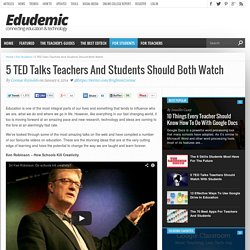
However, like everything in our fast changing world, it too is moving forward at an amazing pace and new research, technology and ideas are coming to the fore at an alarmingly fast rate. We’ve looked through some of the most amazing talks on the web and have compiled a number of our favourite videos on education. These are the stunning ideas that are at the very cutting edge of learning and have the potential to change the way we are taught and learn forever. Ken Robinson – How Schools Kill Creativity. Response to Intervention. Solving an advanced math problem independently requires the coordination of a number of complex skills.
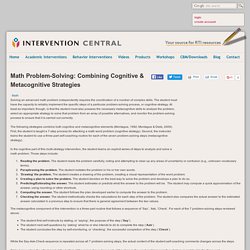
The student must have the capacity to reliably implement the specific steps of a particular problem-solving process, or cognitive strategy. At least as important, though, is that the student must also possess the necessary metacognitive skills to analyze the problem, select an appropriate strategy to solve that problem from an array of possible alternatives, and monitor the problem-solving process to ensure that it is carried out correctly.
The following strategies combine both cognitive and metacognitive elements (Montague, 1992; Montague & Dietz, 2009). First, the student is taught a 7-step process for attacking a math word problem (cognitive strategy). Second, the instructor trains the student to use a three-part self-coaching routine for each of the seven problem-solving steps (metacognitive strategy). Reading the problem. References. Facebook. Knowing Our Students as Learners. Suggestions for Writing a Philosophy Statement. The Best Education Posts of 2013: The Edutopia Top 10 Deep Dive. Image credit: iStockphoto Editor's note: Looking back on 2013, Edutopia has had a fantastic year.

With more than 650 blog posts, 6700 comments and thousands of daily interactions with educators on our social media channels, we're thrilled to be connecting with so many talented and hard-working teachers, administrators, parents and students. To close out the year, we asked one of our newer bloggers, Vicki Davis, for her roundup of our ten most trafficked posts -- some of which were written in previous years -- and why they're still resonating with educators.
Looking at the ten blog posts that really grabbed our attention 2013, I'm struck by how many of these are timeless topics for teachers. It's obvious that teachers, rather than being told what to do, prefer clear examples of how it's being done successfully today. Building Brain Literacy in Elementary Students.
Practice Makes Perfect For many students, the brain isn't a hot topic of conversation.
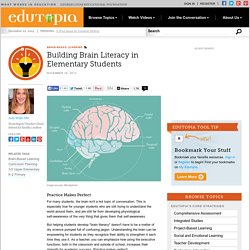
This is especially true for younger students who are still trying to understand the world around them, and are still far from developing physiological self-awareness of the very thing that gives them that self-awareness. But helping students develop "brain literacy" doesn't have to be a matter of dry science pumped full of confusing jargon. Facebook. Creating Thoughtful Readers Through Habits of Mind. Create a new Common Core rubric. Performance Based Assesments. PERFORMANCE ASSESSMENT. Number 2 September 1993 WHAT IS IT?
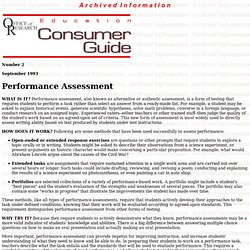
Performance assessment, also known as alternative or authentic assessment, is a form of testing that requires students to perform a task rather than select an answer from a ready-made list. For example, a student may be asked to explain historical events, generate scientific hypotheses, solve math problems, converse in a foreign language, or conduct research on an assigned topic. Experienced raters--either teachers or other trained staff--then judge the quality of the student's work based on an agreed-upon set of criteria.
Kids Speak Out on Student Engagement. A while back, I was asked, "What engages students? " Sure, I could respond, sharing anecdotes about what I believed to be engaging, but I thought it would be so much better to lob that question to my own eighth graders. The responses I received from all 220 of them seemed to fall under 10 categories, representing reoccuring themes that appeared again and again. Sunburst.usd.edu/~kreins/extras/Using Lesson Study and four column lesson planning with preservice teachers.pdf. Www.edutopia.org/pdfs/stw/edutopia-cochrane-schturnaround-PD-essential-questions.pdf. Express 8.24 - You Can't Do That with a Worksheet. You Can't Do That with a Worksheet Stefanie D.
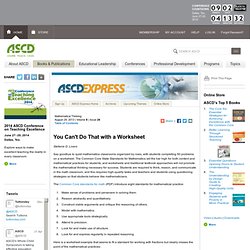
Livers Say goodbye to quiet mathematics classrooms organized by rows, with students completing 50 problems on a worksheet. The Common Core State Standards for Mathematics set the bar high for both content and mathematical practices for students, and worksheets and traditional textbook approaches will not promote the mathematical thinking necessary for success. Students are required to think, reason, and communicate in the math classroom, and this requires high-quality tasks and teachers and students using questioning strategies so that students behave like mathematicians.
The Common Core standards for math (PDF) introduce eight standards for mathematical practice: Bell Ringer Exercises. Because of pressure to teach bell-to-bell -- the pedagogical equivalent of force-feeding geese to make foie gras -- many classrooms now start with bell work, short exercises that students complete while the instructor attends to attendance and other administrative chores.
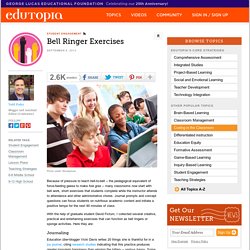
Journal prompts and concept questions can focus students on nutritious academic content and initiate a positive tempo for the next 90 minutes of class. With the help of graduate student David Fictum, I collected several creative, practical and entertaining exercises that can function as bell ringers or sponge activities. Www.nmta.nesinc.com/PDFs/NMTA_Faculty_Guide.pdf. How to Make a Good First Impression at a Job Interview. You know the old saying, “You never get a second chance to make a first impression.”
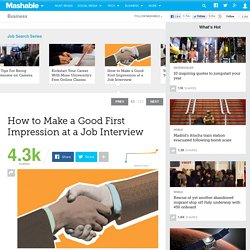
That’s always the case when meeting someone for the first time, but especially so when it comes to a job interview. Reflective Practice - Reflecting on. Chapter 5: Activities - Facilitating Reflection: A Manual for Higher Education. Although the Reflection Circle is a basic structure for reflection, not all groups or group members are comfortable or interested in speaking up in this environment right away.
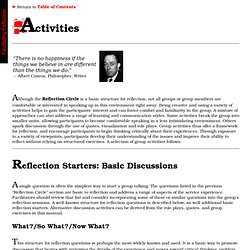
Being creative and using a variety of activities helps to gain the participants' interest and can foster comfort and familiarity in the group. A mixture of approaches can also address a range of learning and communication styles. Some activities break the group into smaller units, allowing participants to become comfortable speaking in a less intimidating environment. Others spark discussion through the use of quotes, visualization and role plays. Group activities thus offer a framework for reflection, and encourage participants to begin thinking critically about their experiences. Reflection Starters: Basic Discussions. A Preemptive Approach to Busy-ness - Federal Way, WA. Cross post from the @WashingtonASCD Emerging Leader blog.
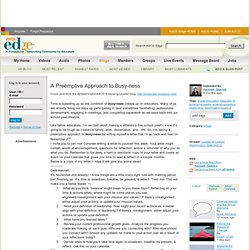
How Do I Assess Individual Learning When Students Work Together?